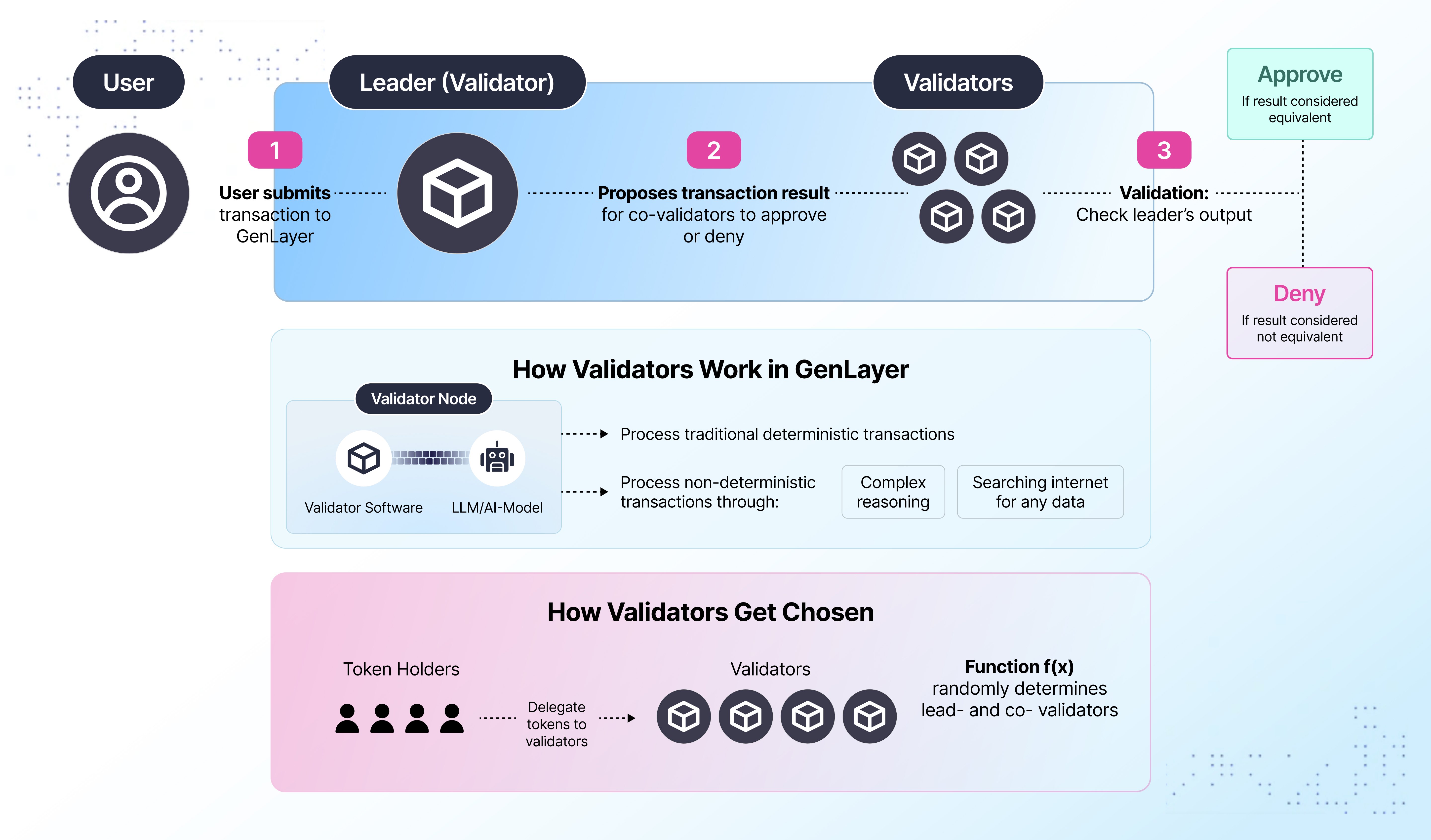What is GenLayer?
GenLayer is the first AI-native blockchain built for AI-powered smart contracts—called Intelligent Contracts—capable of reasoning and adapting to real-world data. Its foundation is the Optimistic Democracy consensus mechanism, an enhanced Delegated Proof of Stake (dPoS) model where validators connect directly to Large Language Models (LLMs). This setup allows for non-deterministic operations—such as processing text prompts, fetching live web data, and executing AI-based decision-making—while preserving the reliability and security of a traditional blockchain.
Core Technology
At the heart of GenLayer lies Optimistic Democracy—an enhanced Delegated Proof of Stake (dPoS) consensus mechanism that integrates AI models directly into validator operations. This synergy delivers three capabilities traditional blockchains cannot match:
- On-Chain AI Processing
Validators connect to leading AI models (GPT, LLaMA, Meta, etc.) to execute complex reasoning on-chain, from natural language comprehension to data-driven predictions.
- Consensus-Backed Security
Multiple validators vote on outcomes, ensuring collective agreement and robust reliability for every transaction—even those involving non-deterministic AI outputs.
- Intelligent Contracts
Smart contracts in GenLayer gain reasoning abilities, allowing them to understand natural language, process real-world data, and adapt to evolving conditions.
Technical Implementation
To integrate AI seamlessly with the blockchain, GenLayer employs a distributed neural consensus network, wherein validators run specialized software connected via API to advanced AI models. This approach unifies:
- Delegated Proof of Stake (dPoS) for efficient block production and governance.
- Neural Consensus for non-deterministic transactions requiring advanced AI reasoning.
This architecture supports autonomous DAOs, self-executing prediction markets, and dynamic DeFi protocols that react to real-world data in real time.
Optimistic Democracy: How Consensus Works

Inspired by Condorcet's Jury Theorem (opens in a new tab) (click the link to check out our interactive model), Optimistic Democracy merges probabilistic AI systems with deterministic blockchain rules, ensuring secure and accurate consensus at scale.
-
User Submits a Transaction A user sends a transaction request to the network (see the diagram's Step 1).
-
Leader (Validator) Proposes Result The network selects a Leader, who processes the request and proposes an outcome (Step 2).
-
Validators Recompute A group of Validators independently re-compute the transaction (Step 3). If the output aligns with the Leader's proposal, they approve; otherwise, they deny.
This multi-layer validation ensures majority agreement, adding a safety net for AI-driven computations.
Validator Selection Mechanism
Token holders bolster network security by delegating tokens to validator candidates. A deterministic function f(x) then randomly designates Leader-Validator and Validators for each transaction. This process not only promotes fairness but also helps decentralize validation power, strengthening GenLayer's security and trustlessness.
Validator Operational Framework
Each GenLayer validator node integrates:
-
Validator Software Handles core blockchain functions: networking, block production, and transaction management.
-
AI Model Integration Connects to Large Language Models (LLMs) or other AI services for complex reasoning, natural language processing, and real-time data retrieval.
Validators seamlessly manage both:
- Deterministic Transactions typical of traditional blockchains.
- Non-Deterministic Transactions that leverage AI-driven logic (e.g., searching the internet, analyzing data, making probabilistic inferences).
By splitting tasks between standard deterministic and advanced AI-powered transactions, GenLayer ensures high performance without compromising on security.
Putting It All Together
With Optimistic Democracy guiding consensus and validators empowered by AI, GenLayer enables a new class of blockchain applications. From DAOs that self-govern based on real-time data to DeFi protocols that dynamically adjust parameters in response to market changes, developers can now build truly intelligent decentralized solutions.